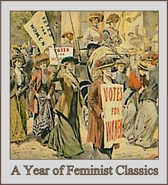Published: 1989, 2001 (I read the 1989 edition.)
It's about:
This is a study of five artists engaged in that act of creation that engages us all--the composition of our lives. Each of us has worked by improvisation, discovering the shape of our creation along the way, rather than pursuing a vision already defined.
 Cultural Anthropologist Mary Catherine Bateson explores how five women have learned to shape their lives around unforeseen and unplanned circumstances, many of which most American women face today.
Cultural Anthropologist Mary Catherine Bateson explores how five women have learned to shape their lives around unforeseen and unplanned circumstances, many of which most American women face today.This book is about life as an improvisatory art, about the ways we combine familiar and unfamiliar components in response to new situations, following an underlying grammar and an evolving aesthetic.
Bateson sees discontinuities and interruptions in life, such as raising children, career changes, and divorce, as creative material rather than disruption, and she seeks to create a unifying thread of all life experience.
Just as change stimulates us to look for more abstract constancies, so the individual effort to compose a life, framed by birth and death and carefully pieced together from disparate elements, becomes a statement on the unity of living. These works of art, still incomplete, are parables in process, the living metaphors with which we describe the world.
I thought:
This book was mentioned in passing in one of my classes, and it's premise sounded interesting to me so I checked it out of the library. It definitely met my expectations. Mary Catherine Bateson is clearly a very intelligent woman, and I appreciated how direct and succint her writing was. She didn't try to make a non-fiction book too poetic or "pretty" (like another somewhat similar non-fiction book I've read this past year.)
The one criticism I have of this book is that the strong focus on gender issues is a bit dated. This didn't bother me too much since I am interested in the history of feminism in the United States, but women simply don't face the same problems to the extent that Bateson describes in this book.
Overall, this book was well written, clear, straightforward, and described intelligent way of viewing the world and composing a life from a woman's point of view. I loved the idea of taking the initiative in shaping your own identity around wherever your circumstances place you. I loved thinking of my own life as a personal art project. Loved this book.
From a more personal point of view, this book fulfilled a need I've had to come to terms with certain aspects of my religion that have been difficult for me to deal with.
Each of us has repeatedly had to salvage a capacity for commitment as we become aware of the flaws of institutions and indeed of the individuals who seemed to embody those commitments. Like all the other discontinuities we have faced, this implies possibility as well as loss, the need to construct a new mode of self-preservation, and, finally, commitment without dependency ... today I find myself believing once again that it is worthwhile to try to work gradually within an imperfect system, to look for ways in which values already embedded in it, however ambiguously, can find fuller expression.
Reading Recommendations: If philosophy is more your thing, one of my favorite books is Nietzsche: Life as Literature
Warnings: None.
Favorite excerpts:
Women’s lives have always been grounded in the physical by the rhythms of their bodies and the giving and receiving of concrete and specific tokens of love, a ring or a teaspoon of cough syrup. (20)
Composing a life involves a continual reimagining of the future and reinterpretation of the past to give meaning to the present, remembering best those events that prefigured what followed, forgetting those that proved to have no meaning within the narrative. (30)
For Americans today, composing a life means integrating one’s own commitments with the differences created by change and the differences that exist between the peoples of the world with whom we increasingly come into contact. (59)
Although we are extraordinarily romantic about marriage, we are curiously blind to the joys and benefits of real partnership. Modern ideas about the relationship between work and home, with a monetary value put on work and a tendency to devalue all forms of labor that do not bring in money, have sharpened this division. What is perhaps more serious is the fact that these separations, like the exclusion of the talents of large sections of the population, have caused us to forego important kinds of creativity. (78)
A single dimension of difference is not enough. If two alternatives are contrasted in only one way, they may seem easily ranked, as grade-school children rank their buddies. If the differences multiply, ranking is harder. (105)
The ideal is to find simple forms that can be elaborated for delight or turned into art rather than onerous obligations. (128)
etc.
What I'm reading next: Beyond Belief by Elaine Pagels (which I probably won't review because I'm reading it for school and it's not terribly interesting to me.)








